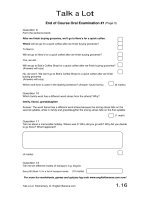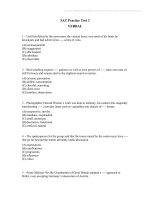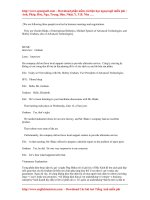College test english 3 pptx
Bạn đang xem bản rút gọn của tài liệu. Xem và tải ngay bản đầy đủ của tài liệu tại đây (66.37 KB, 6 trang )
CHAPTER 3 • LearningExpress Skill Builders
54
more than the literal details to appreciate the attitudes
and emotions conveyed in the writing.
As soon as she sat down on the airplane,
Rachel almost began to regret telling the travel
agent that she wanted an exotic and romantic
vacation. As the plane hurled toward Rio de
Janeiro, she read the information on Carnival
that was in the pocket of the seat in front of
hers. The very definition of Carnival made her
shiver. It was from the Latin carnavale,
meaning a farewell to the flesh. She was
searching for excitement, but had no intention
of bidding her skin good-bye. Carnival, the
brochure informed her, originated in Europe in
the Middle Ages and served as a break from the
requirements of daily life and society. Most of
all, it allowed the hard-working and
desperately poor serfs the opportunity to
ridicule their wealthy and normally humorless
masters. Rachel, a middle manager in a
computer firm, wasn’t entirely sure whether
she was more serf or master. Should she be
making fun, or would others be mocking her?
She was strangely relieved when the plane
landed, as though her fate were decided.
Rachel chewed on her lower lip as she stood
before the mirror in her hotel room, choosing
first one dress then another, trying to decide
which outfit was the most serf-like. Nothing in
her dress for success seminar had prepared her
for this all-important decision. Finally, wearing
her brightest blouse and skirt, she headed for
the street, determined to find adventure.
1. The main idea of this passage is
a. life in Rio de Janeiro
b. a brief history of Carnival
c. a traveler on an exciting vacation
d. dress is an important decision at Carnival
2. Rachel was nervous on the airplane because she
a. was afraid to fly.
b. was taking a risk and trying something
very new.
c. forgot her traveler’s checks and had no
other money.
d. was worried she would lose her luggage.
3. The passage implies that Rachel
a. is traveling alone.
b. takes a vacation every year.
c. has never traveled abroad before.
d. speaks Portugese.
4. According to the passage, Carnival
a. lasts for several days.
b. originated in Europe.
c. occurs in February.
d. is famous for good food.
5. Which of these sentences would most logically
begin the next paragraph of this story?
a. Settling herself comfortably at a table in
the hotel coffee shop, Rachel began writ-
ing a postcard to her mother.
b. Later that night, Rachel tossed in her bed,
worried about the money she was spend-
ing.
c. Rachel entered the huge office building
and rode the elevator to the twelfth floor,
the location of her 9:00 business meeting.
d. As soon as she left the hotel, the sights
and sounds of Carnival surrounded
Rachel.
–BASIC SKILLS FOR COLLEGE–
LearningExpress Skill Builders • CHAPTER 3
55
■
For question 1 choice c captures the main idea.
All the other choices are mentioned in the pas-
sage but are minor points.
■
For question 2 choice b is implied in the first
paragraph.
■
For question 3 choice a is correct. We can infer
that Rachel is traveling alone because no one
else is mentioned. Any of the other choices
could be true, but there is nothing in the pas-
sage to support them.
■
For question 4 choice b is correct. Look at the
first paragraph. The other choices happen to be
true of Carnival, but they are not mentioned in
the passage.
■
For question 5 choice d is correct. The last line
of the passage shows Rachel headed from her
hotel room to the street where Carnival is tak-
ing place. Thus, a logical continuation is for
Rachel to be experiencing the adventure she is
determined to find.
INTERPRETING VISUAL
INFORMATION
Visual information is just a fancy way of saying tables,
graphs, and charts. Each of these is a way of organiz-
ing information so that it can be easily seen and iden-
tified. You’ll find visual information in your daily
reading. For example, if you want to know the weather
conditions in any part of the globe, there’s a table and
map showing you the temperature the previous day, the
current day, and the predicted temperature for the
next day. If you are traveling, this information comes
in quite handy because it helps you prepare the cloth-
ing you need to put in your suitcase. In fact, climatol-
ogists create many tables and charts as they work. Take
a look at the table that follows.
FUJITA-PEARSON
TORNADO INTENSITY SCALE
Classification Wind Speed Damage
F0 72 MPH Mild
F1 73–112 MPH Moderate
F2 113–157 MPH Significant
F3 158–206 MPH Severe
F4 207–260 MPH Devastating
F5 260–319 MPH Cataclysmic
F6 319–379 MPH Overwhelming
Based on the Fujita-Pearson Tornado Intensity
Scale, read and answer the questions that follow.
1. A tornado with a wind speed of 173 MPH would
be assigned which classification?
a. F0
b. F1
c. F2
d. F3
2. The names of the categories in the third column,
labeled “Damage,” would best be described as
a. scientific.
b. descriptive.
c. objective.
d. whimsical.
ANSWERS
1. d. A wind speed of 173 mph falls between158 and
206, which is the range for an F3 tornado; thus
choice d is the correct choice.
2. b. Here you must use the inference skill we dis-
cussed earlier.Applying words such as mild, mod-
erate, severe, devastating, and cataclysmic to the
damage done by a tornado is a means of describ-
ing the damage; therefore the words are descrip-
tive. Choice b is the correct choice.
–READING COMPREHENSION–
CHAPTER 3 • LearningExpress Skill Builders
56
Look at the chart below and respond to the
questions.
Answer the following questions as TRUE or
FALSE.
______ 1. By1937 banking regulations seem to have
restored consumer confidence in the bank-
ing industry.
______ 2. There was no appreciable difference in the
number of bank failures between 1926
and 1933.
______ 3. By1937 the banking industry had reached
the highest rate of stability it had shown
since 1926.
______ 4. There were 500 more banks that failed in
1933 than failed in 1931.
ANSWERS
1. True
2. False
3. True
4. True
Not all tables, graphs, and charts are as simple as
these two examples. However, one guideline that you
should always follow when working with visuals is to
examine the key or the legend. This gives you impor-
tant information about the size, number, and location
of the information that will help you draw conclusions.
In the graph above it was important for you to know
that each X represented 250 banks.
VOCABULARY
You’ve heard the term context clues many times through-
out your school years. And there is no doubt that
searching for clues to the definition of unfamiliar
words is especially important when you are trying to
read and understand new subjects. Consider the fol-
lowing words:
inundated
alleviate
relinquished
meticulous
incredulous
Can you provide a synonym? Can you explain the
meaning? It’s difficult when you see the word in isola-
tion. See if the following sentences, which use the
words in context, help you.
1. As soon as the details of the election were
released to the media, the newspaper was inun-
dated with calls—far too many to be handled
effectively.
a. provided
b. bothered
c. rewarded
d. flooded
2. Since the townspeople were so dissatisfied, var-
ious methods to alleviate the situation were
debated.
a. ease
b. tolerate
c. clarify
d. intensify
BANK FAILURES IN THE UNITED STATES
FROM 1926 TO 1937
1926 X X X X
1931 X X X X X X X X X
1933 X X X X X X X X X X X
1937 X
KEY: Each X represents 250 banks.
–BASIC SKILLS FOR COLLEGE–
LearningExpress Skill Builders • CHAPTER 3
57
3. I relinquished my place in line to go back and talk
with my friend Alex.
a. defended
b. yielded
c. delayed
d. remanded
4. The doctor was determined to find the cause of
her patient’s illness, no matter how well-
disguised it might be, so her examination of Mrs.
White was meticulous.
a. delicate
b. painstaking
c. superficial
d. objective
5. When people heard that Bob, who was afraid of
heights, took up skydiving, they were incredu-
lous.
a. fearful
b. outraged
c. convinced
d. disbelieving
You should have noticed that with careful exam-
ination of the word in the context of a complete sen-
tence, you were able to derive a sense of its meaning.
The answers for the above questions are:
1. d
2. a
3. b
4. b
5. d
However, to fully understand a word you must also
use a dictionary.Context clues will help get you through
a piece of reading without having to interrupt it every-
time you come upon a new word. The dictionary, how-
ever, is the only place to give you a full definition with
possible multiple meanings.
HINT: If you own the book you are reading, cir-
cle new words as you find them. Use context clues as
your preliminary guide and then go back and use the
dictionary for all the words you circled.
Apply context clues to new vocabulary words in
the following excerpt from the short story “Paul’s Case”
by Willa Cather.
It was Paul’s afternoon to appear before the
faculty of the Pittsburgh High School to
account for his various misdemeanors. He had
been suspended a week ago, and his father had
called at the Principal’s office and confessed his
perplexity about his son. Paul entered the
faculty room suave and smiling. His clothes
were a trifle outgrown, and the tan velvet on
the collar of his open overcoat was frayed and
worn; but for all that there was something of
the dandy about him, and he wore a red
carnation in his buttonhole.
1. The word misdemeanors most likely means
a. accomplishments.
b. crimes.
c. offenses.
d. rewards.
2. The word perplexity most likely means
a. innocence.
b. confusion.
c. anger.
d. support.
3. The word trifle
most likely means
a. seriously.
b. insignificantly.
c. noticeably.
d. terribly.
–READING COMPREHENSION–
CHAPTER 3 • LearningExpress Skill Builders
58
4. The word frayed most likely means
a. ripped.
b. faded.
c. worn down.
d. freshly cleaned.
5. The word dandy most likely means
a. gentleman.
b. soldier.
c. teacher.
d. scholar.
If you read the paragraph as a whole you should
recognize that Paul is being suspended from Pitts-
burgh High School, and that misdemeanors are prob-
ably the wrong deeds or offenses that he has committed.
His father confessed perplexity about his son. Because
the author used the word confessed we can infer that
Paul’s father feels somewhat guilty about his son’s
behavior.It could also mean that the father is confused,
is confessing that he didn’t understand his son, and is
guilty for not being more aware of his son’s actions. That
Paul’s clothes were a trifle outgrown could mean very
or a little, and the fact that his collar is frayed could mean
almost anything from dirty to torn. However, the author
goes on to describe Paul as a dandy with a red carna-
tion in his buttonhole. So, if Paul is wearing a red car-
nation, it most likely means that he is trying hard to
dress up a coat that is a little worn because of a torn
collar, and he is trying to look like a fine gentleman or
a dandy.
But you should go back and check the dictionary
for words you do not know. You will find that many
words have multiple meanings and that often words
used in one time period have adopted new meanings
in contemporary usage. The word dandy, for example,
has more than one meaning, as does the word trifle. Tr y
to view every encounter with a new word as an oppor-
tunity to develop your language skills.
ANSWERS
1. b
2. b
3. b
4. c
5. a
FACT AND OPINION
Simply stated, facts are what you know and opinions are
what you believe. Commonly held beliefs, shared by
many people, can be mistaken for facts, but facts must
meet the documentary evidence test. It is the simple dis-
tinction that facts can be proven to be true, while beliefs
cannot be proven to be true, which separates them.Your
religious beliefs, for example, are opinions, not facts.
Your faith in their truth may make you, personally,
accept them as facts. But unless your beliefs can be sci-
entifically proven, they cannot be known as facts. Let’s
look at the following sentences to see if you can dis-
tinguish fact from opinion.
1. The cafeteria serves lunch from 12–2.
2. The cafeteria’s food is really delicious.
It should be pretty clear to you that (1) is a sim-
ple fact and (2) is clearly an opinion or belief.
Read these two sentences and decide whether
they tell a fact or express an opinion.
1. College athletes earn one-tenth the money that
professional athletes earn.
2. College athletes are underpaid.
The first sentence is a statement of fact. It can be
substantiated and proven with data. On the other hand,
sentence two is a statement of belief. It claims that col-
–BASIC SKILLS FOR COLLEGE–
LearningExpress Skill Builders • CHAPTER 3
59
lege athletes are underpaid, and there are many who
would disagree. Some would say that the value of
tuition-free education, room and board, and the future
earning capacity that a college education and athletic
training provides more than compensates college ath-
letes. But those same people cannot dispute that col-
lege athletes earn one-tenth the salary that professional
athletes earn. All they can argue is that it isn’t fair or
equitable, and that argument immediately throws the
statement into the realm of opinion or belief.
So one way to distinguish fact from opinion is to
apply the debate test. If a statement can be debated it
is opinion, not fact. Read these statements.
1. Carbon dioxide emissions produce unhealthy air.
2. The Environmental Protection Agency must
enforce legislation to protect the air from increased
carbon dioxide emissions.
Sentence one (1) is a claim of fact. It cannot be
disputed that carbon dioxide emissions harm air qual-
ity. Scientific data eliminates all debates. But how we
feel about that fact, and how we use that fact, is what
takes it from fact to opinion, or belief.For example, sen-
tence two (2) uses the fact that CO
2 is an air pollutant
to suggest the need for government enforcement of air
quality controls. Many Americans would disagree that
such intervention is either needed or even constitu-
tional. Notice, the disagreement is not about the fact,
but about how the fact is used.
Next, decide whether the following statements are
fact or opinion.
1. All Americans have the right to healthcare.
2. Congress has required the implementation of a
new TV ratings system to aid parents in the selec-
tion of appropriate viewing for their children.
3. The new TV ratings system represents yet another
unnecessary effort on the part of the govern-
ment to reduce individual responsibility.
4. Affirmative action programs are morally correct
for America.
5. Legalization of assisted suicide would benefit ter-
minally ill patients by giving them more control
of their own destiny.
You’ll notice that these statements aren’t quite as
easy to work with as the first group of sentences. But
you must remember the debate test and decide if the
statement can be argued. Is it a fact or an opinion that
all Americans have the right to health care? Well, about
the only thing debatable in that statement is who
should pay for the care? And how should it be provided?
Statement one is a fact; where we go with it presents
the debate.
Statement two is also a claim of fact.You may not
agree with what Congress did, and you may even dis-
agree with the whole concept of censoring what chil-
dren watch on TV, but the statement simply says that
Congress has legislated that there must be a system to
do it.
Statement three is definitely a claim of opinion
or belief. Whether or not the ratings system was nec-
essary and whether or not the system will increase or
decrease individual responsibility is highly debatable.
But the fact remains; there is now a system of ratings.
Statement four is also a claim of opinion or
belief. It isn’t telling us whether or not there are affir-
mative action programs, which would be a claim of fact,
but it is telling us that these programs are morally cor-
rect.
Statement five is a claim of fact. Legalizing assisted
suicide would give the terminally ill more control. This
is a highly charged claim of fact with lots of arguments
–READING COMPREHENSION–









